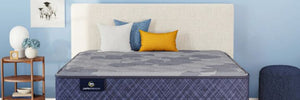What is Memory Foam? Understanding Its Benefits and Uses

Key Highlights
- Memory foam is a type of viscoelastic polyurethane foam that softens with body heat and molds to your shape, offering excellent pressure relief and personalized support.
- Originally developed by NASA in the 1960s to reduce pressure-related injuries during space travel, memory foam entered the mattress market in the early 1990s, with Tempur-Pedic leading the way.
- Today, memory foam comes in several variations, including traditional, gel-infused, and plant-based foams—each offering benefits like improved cooling, sustainability, or enhanced responsiveness.
- A major perk of memory foam is its motion isolation—movement on one side of the bed doesn’t easily transfer to the other, making it ideal for couples.
- Memory foam is also durable and hypoallergenic, making it a great long-term investment for those seeking both comfort and cleanliness in their sleep environment.
-
Let’s explore what makes memory foam such a popular choice in modern mattresses, from its history to its various types and performance benefits.
Introduction: What Is Memory Foam?
Memory foam—technically known as viscoelastic polyurethane foam—is a unique material designed to respond to body heat and pressure. It softens as you lie down, conforming to your body’s contours, and then slowly returns to its original shape once pressure is removed. This characteristic gives it an edge in comfort and support, making it a favorite in mattresses, pillows, and even medical equipment.
But how did a space-age invention become the go-to sleep surface for millions? To understand memory foam’s appeal, it helps to look at how it was created and how it’s evolved.
Origins: NASA’s Role in the Development of Memory Foam
Definition and Basic Properties
Memory foam is a type of polyurethane foam. Experts also call it viscoelastic polyurethane foam. It is made to give you comfort. Memory foam gets softer with your body heat and shapes itself around you. One key thing about memory foam is it goes back to its original form after you get up. This helps it to last longer and stay as good as new for a long time.
The viscoelastic polyurethane foam in memory foam makes it work well for different needs. It can match the shape of the body which helps give relief at pressure points like your hips and shoulders. By doing this, memory foam helps balance your body weight across the full surface.
Memory foam has another useful feature. It has an open-cell structure that lets air move through. While traditional mattresses can keep heat in, memory foam helps solve heat retention. This means it can keep you cooler during sleep. These benefits have helped make memory foam very important, especially in bedding and many other products.
Historical Development and NASA's Role
The start of memory foam is linked to NASA's space program from the 1960s. It came from work at the Ames Research Center, where it began as temper foam. The idea was to help protect astronauts from strong G-forces when taking off or coming back down.
NASA did not use this foam in its space shuttles, but people soon saw what it could do besides that. By the 1980s, companies such as Fagerdala World Foams got the formula and the rights to use it. This led to new mattresses. In 1991, Tempur-Pedic® brought memory foam to many people and made it popular for homes.
NASA's idea helped with more than just sleep products. Memory foam is now in things like medical devices and sports gear. It has changed and improved with new ways to make it and new features. It now plays a big part in how people all over the world think about sleep quality.
Types of Memory Foam Available
Memory foam now comes in different types, each made for what people like best. Traditional memory foam is known to fit well to your body and give good pressure relief. It reacts slowly and can keep in heat, so it might feel warm at times. Gel-infused foam adds special cooling features, so it works well for people who feel hot at night.
Plant-based memory foam uses some natural things like castor oil. This makes it a better choice for people who care about the planet, but it still gives the same soft feel as traditional memory foam. These new kinds of memory foam help people pick what fits their needs best, whether it is about heat, protecting the environment, or lasting a long time.
Traditional Memory Foam
Traditional memory foam is the first type of viscoelastic polyurethane foam. It is known for its slow response time. This means the foam shapes to your body well. It can help take stress off your joints and help blood move better. With its heat retention, the foam gets softer as your body heat warms it. You get comfort that feels just right for you.
There are some good things about traditional memory foam. One is motion isolation. This means it can absorb your movements. It helps so you do not disturb the person next to you at night. The dense build makes it last long, too. So, it is a good choice for couples or people who want firm and steady support.
But, there is one thing to watch out for. This type of polyurethane foam can trap heat because of its heat retention. That can make hot sleepers feel too warm. Many new mattress companies now try to fix this problem. They add features to make the bed cooler. Still, many people like traditional memory foam for how warm and snug it feels all over at night.
Gel-Infused Memory Foam
Gel memory foam takes the regular memory foam and adds gel particles to its foam layers. This helps with heat retention by pulling away extra heat and making the sleep surface cooler. The gel beads also have “phase-changing” materials that take in and let out heat, much like how ice packs work.
This type of foam is still great for pressure relief, as it shapes to your body and supports the spine. It helps spread your body weight evenly so you feel comfortable. The gel memory foam also helps the mattress bounce back faster, so you can change sleep positions easily without feeling like you get stuck.
Still, gel-infused memory foam isn't perfect. When the gel beads warm up as much as they can, the cooling effect is not as strong. But, this type of foam is a good choice if you want a cooler sleep surface and often get too warm at night because of heat retention.
Plant-Based Memory Foam
Plant-based memory foam is a more eco-friendly choice than the ones made from oil. This memory foam uses castor oil and other plant materials, which helps cut down on chemicals while still giving you the same comfort you get from regular memory foam.
The foam uses open-cell technology, so it allows air to pass through more easily. This helps with breathability and keeps the temperature steady during sleep. Since it is made from renewable resources, it fits into the new trend of using green technology. This type of mattress helps the environment and still gives you support and pressure relief without losing out on quality or feeling.
A big benefit of this memory foam is that it has less off-gassing compared to normal options, which is good for people who are sensitive to smells. This foam is lightweight and reacts well to movement. It shows that you can be more eco-friendly and still get comfort at the same time.
Benefits of Using Memory Foam
Memory foam products have many good benefits. They give great support and help you feel more comfortable. Memory foam shapes to the body, so it can help with pressure points. This gives people a more calm place to sleep. The material is also good for people who want to keep away dust mites and other allergens.
Another good thing is that memory foam can help with spinal alignment. This may lower back pain and help you stand or sit with better posture. You can use it for a long time, so it is a smart buy for both health and comfort. Next, we will look at each of these benefits one at a time.
Comfort and Pressure Relief
The main feature of memory foam is that it helps take pressure off your body. When you lay on it, the memory foam shapes around you. This supports your hips, shoulders, and head. This soft support spreads your body weight across the bed, taking stress off pressure points and making you more comfortable during the night.
Pressure relief is very important for people with injuries or sore joints. Memory foam is good at cushioning these areas. This can help you have a deeper sleep that is not disturbed.
No matter if you sleep on your side, back, or even move between both, this material will adjust to your way of sleeping. It keeps its shape and molds to your body's needs. Because of this, memory foam offers a sleeping experience made just for you.
Support and Spinal Alignment
Memory foam helps support your spine in a more natural and comfortable way. It shapes itself to your body, keeping your back in a healthy position and helping to reduce strain and back pain.
Because of this soft but steady support, many people with chronic back pain choose memory foam for their beds. It does not sag or develop soft spots like other kinds. This means you get the same good support for your back, even after a long time.
If you move around a lot at night, the memory foam will change with you. It keeps giving your back the right support no matter how you sleep. This helps your sleep be better and keeps your spine healthier.
Hypoallergenic Properties
One of the best things about memory foam is that it helps keep out allergens. The material is thick and works as a strong barrier. This stops dust mites, bacteria, and fungi from getting in. These are some of the common things that people can be allergic to, and they do not do well on memory foam.
Memory foam is good for those who worry about the air in their home too. It gives off fewer volatile organic compounds (VOCs), mainly if you pick eco-friendly or plant-based memory foam options. With fewer chemicals in the air, the air around your bed will be better to breathe.
When you use memory foam with a mattress protector, it can keep the bed clean and help your health. This makes it a good pick for a home where some people may have allergies.
Common Uses of Memory Foam
Memory foam is used in more than mattresses. You can find it in bedding products like pillows and in medical devices too. The way memory foam can change and adjust helps make many parts of our daily life better. The support this material gives makes things more comfortable and useful.
You also see memory foam used in many kinds of seats. It can help you feel better when you have to sit for a long time. Every product that uses memory foam shows how it can give the right amount of comfort to meet your needs.
In Mattresses and Topper Pads
The most common use of memory foam is in mattresses and topper pads. Memory foam beds work well for many ways people like to sleep. They help keep your spine in line all night. At the same time, topper pads are a good way to change traditional mattresses into memory foam beds without spending too much.
These products help sleep quality in many ways. They shape to your body and spread your weight out. They also lower motion transfer so you do not feel when someone moves next to you. The strong build of memory foam means you get long-lasting comfort, and it is less likely to sag over time.
Some traditional mattresses with memory foam can hold in heat. But modern memory foam uses things like gel to help air flow and stop heat retention. This keeps your sleeping surface cool and comfortable.
In Pillows and Other Bedding Products
Memory foam pillows make your bed more comfortable. They give extra support for your head and neck. This is good for people who sleep on their side or back and want relief from stiff muscles.
You will also find memory foam in the comfort layers of mattresses and other bedding extras. This gives you a soft sleep surface that works for all kinds of sleepers. Some new designs will keep you cool at night. They still let memory foam mold to your body for better sleep.
If you need something gentle, there are hypoallergenic bedding products. These are great for sensitive people and make memory foam even more appealing.
In Medical Devices and Seating Solutions
Memory foam is often used in medical devices and in seats made to help people sit better. You can find memory foam in things like wheelchair cushions and hospital mattresses. Its special way of taking pressure off the body helps stop bedsores and makes patients feel better and more comfortable.
When used in seats, memory foam shapes itself to fit your body. This helps to stop strain when you have to sit for a long time. You see memory foam in office chairs, car seats, and gaming chairs. The foam gives good support and changes its feel as you move or sit in a new way.
All these smart uses show that memory foam is not just for one thing. Now, it helps people feel good and healthy every day, in many different places.
How to Choose the Right Memory Foam Product
Picking the right memory foam product comes down to a few things. You need to look at the density and think about cooling. If you pick a memory foam with higher density, you get better support over a long time. If you get hot at night, there are foams with gel added in. These help people who overheat when they sleep.
There are also certifications like CertiPUR-US®. If you see this, it means the foam meets strong safety rules. You should check the firmness, too. Pick one that fits the way you sleep. This will help you get what you need. Let's take a look at how you can make smart choices with all this in mind.
Understanding Density and Firmness
Density and firmness are key parts that shape how good memory foam feels. The foam’s density is measured in pounds for each cubic foot. This tells you how long it will last. Foams with higher density can stay in good shape longer and can support people who are heavier, so the mattress does not lose its shape.
Firmness is checked with something called Indentation Force Deflection (IFD). Foams can be soft, firm, or somewhere in between. Soft foam is a good pick for people who sleep on their side. Those who sleep on their back or stomach may like firmer designs, as they help keep the back in line.
It is important to find the right mix of foam’s density and firmness. When you pick a mattress with care based on what you need, you are more likely to get good rest instead of feeling sore.
Considerations for Hot Sleepers
Hot sleepers often have problems with traditional memory foam because it keeps in heat. Gel-infused memory foam helps with this by using cooling features like gel beads. These beads take in heat and move it away.
There are also open-cell designs. These let more air move through the memory foam so you stay cool. With these new ways to lower heat retention, people can stay comfortable, even in warmer places.
It is good to pick memory foam with cooling features. Also, check product labels. This can help with temperature and make sure you get a better night’s sleep.
Maintenance and Care for Memory Foam Products
Taking care of your memory foam can make it last longer. If you clean it often and use things like mattress covers, you help stop it from wearing out quickly. This can also keep your memory foam clean and nice to use.
You should follow the cleaning steps and look at your mattress for any signs of damage. By doing this, you help your memory foam work well for a long time. Let’s look at some tips that will help you take care of it in the best way.
Cleaning and Maintenance Tips
Taking good care of memory foam can help it last longer. Always use a good mattress protector to keep out spills and stains. This helps protect your mattress and saves you money in the long run. If there is a small spot, use a little bit of mild soap and a damp cloth. Try not to use too much water on the foam.
Air out your mattress now and then in a place with fresh air. This helps keep it feeling fresh. You can also use some baking soda. Just sprinkle a bit on top and let it sit to take out any bad smells.
Vacuum your mattress on a regular basis. This picks up dust and helps stop any allergies. If you follow these easy steps, you will have a cleaner and more comfortable mattress through the year.
Lifespan and Durability
A memory foam mattress can last from 7 to 10 years if you take good care of it. The reason it lasts so long is because of the high-density foam layers which help stop early wear and tear. Still, problems like dips or soft spots can show up after some time. If you notice these, it may be time to get a new one.
|
Factor |
Impact on Lifespan |
|---|---|
|
Density Level |
A higher density gives the mattress a longer life |
|
Maintenance Routine |
Good care helps it stay effective longer |
|
Mattress Protector Usage |
Using a protector keeps it safe from spills or oils |
When you look after these things, you can help your memory foam mattress stay good for many years.
Conclusion
To sum up, memory foam is a special material. It gives you great comfort and support for many things, like beds and health products. If you know about the types, properties, and benefits of memory foam, you can pick the right one for your needs. Memory foam gives good pressure relief, which can help with your back and spine. Some types are also good for people who have allergies.
When you think about using memory foam in your life, you should look at things like how firm it is, how dense it feels, and how you take care of it. This will help make sure it lasts a long time. Try out the versatility of memory foam for yourself and see what it can do for your comfort and support.
Frequently Asked Questions
How long does a memory foam mattress last?
The lifespan of a memory foam mattress is usually about 7 to 10 years. The exact time can depend on how dense the foam is and how well you take care of it. Good care can help stop it from wearing out too soon and help it keep its original form. After some years, if you notice sagging or if it feels soft in the same spot, it may be time to get a new memory foam mattress.
- Juliana Huhta







Comments 0